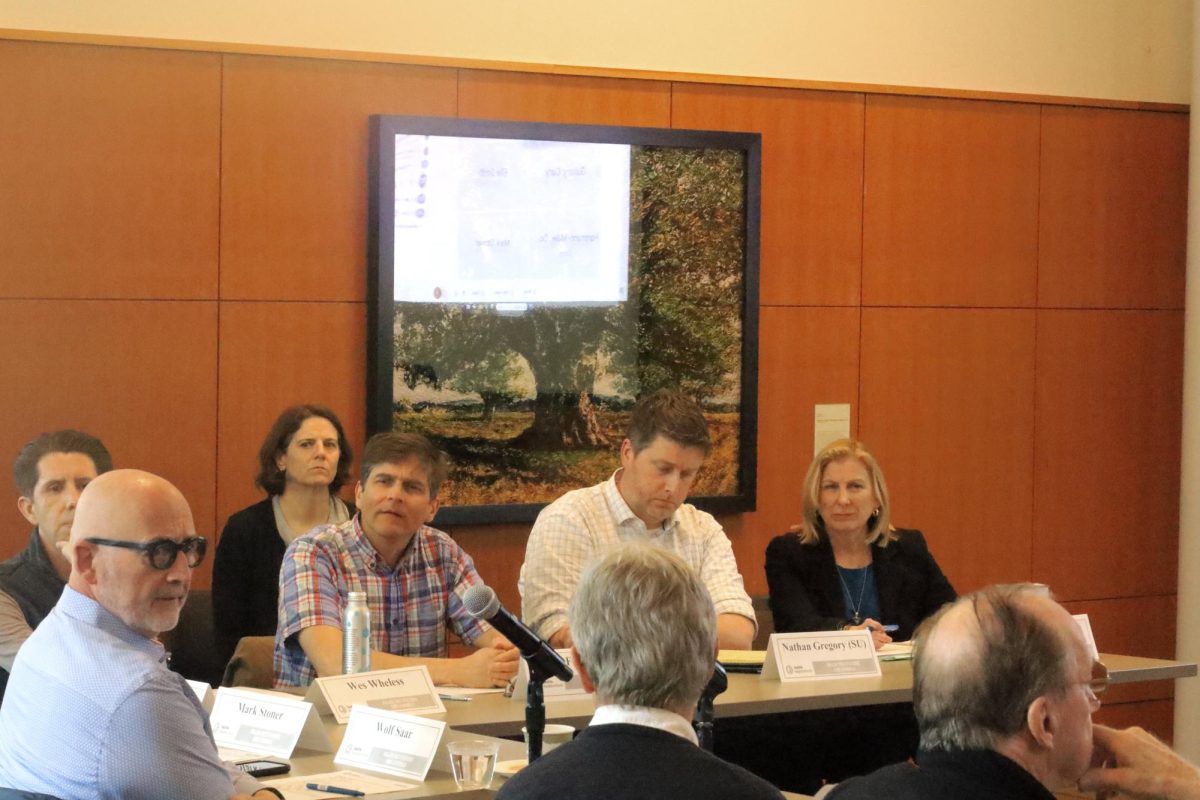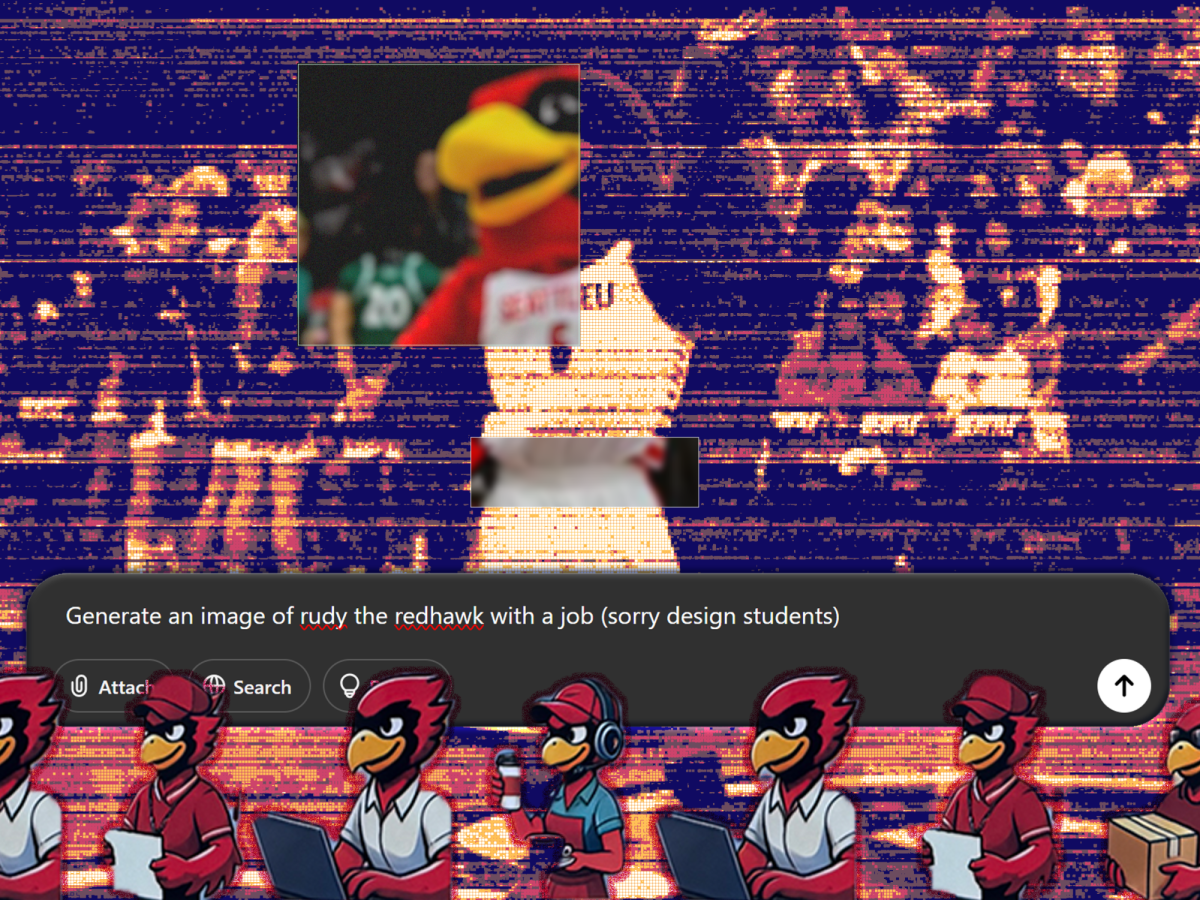 “It seems there are shared functions, at least some, between the Lee Center and the museum,” John Feit, chair of Seattle University’s Implementation Advisory Committee (IAC), said—echoing raised concerns surrounding the planned destruction of the Lee Center. “It seems that there is value in the Lee Center that’s pretty great, tens of millions of dollars worth, and I’m wondering why that isn’t necessarily being recognized.” Following this comment, Feit was met with a round of audience applause.
“It seems there are shared functions, at least some, between the Lee Center and the museum,” John Feit, chair of Seattle University’s Implementation Advisory Committee (IAC), said—echoing raised concerns surrounding the planned destruction of the Lee Center. “It seems that there is value in the Lee Center that’s pretty great, tens of millions of dollars worth, and I’m wondering why that isn’t necessarily being recognized.” Following this comment, Feit was met with a round of audience applause.
Similar sentiments were spoken April 22 at the Advancement and Alumni Building as Seattle U students and faculty, Cornish College of the Arts members and Capitol Hill neighbors gathered for a public meeting regarding the construction of Seattle U’s Museum of Art (SUMA).
The IAC hosted this meeting. A variety of large city institutions, such as the University of Washington and Swedish Medical Center, have an IAC, made up of volunteers appointed by the city government. IACs are designed to work with institutions and surrounding communities to monitor new developments and ensure a balance between the institution’s needs and the interests of the surrounding communities.
Following introductions, Lara Branigan, director of design and construction at Seattle U, gave a presentation about the ongoing process for constructing the SUMA.
According to Branigan, the school is presenting before the IAC earlier than is generally expected due to high public interest. Branigan clarified that while both the architect and the construction company have been selected, neither is yet under contract with the school as the process is currently underway.
As far as visions for what the museum may look like, Branigan detailed that the building would include, in addition to multiple permanent exhibitions that will house the donated 200-plus-piece Hedreen art collection, a painting studio and an object study classroom, as well as multi-use rooms and offices. A pop-up gallery would be incorporated into the design plan, allowing new exhibits to rotate frequently. Exhibition rooms will also be able to display digital and performance art. Branigan also introduced the possibility of a coffee shop or, potentially, a full restaurant within the museum.
“We want this building to be really flexible so that multiple uses can happen in it. Not just a place for you to stare at a piece of art, but for classes to happen in it, for people to come together in it,” Branigan said.
Notably, the museum does not currently have plans to house a theater or the theatre department, unlike the Lee Center. Branigan did not directly address the destruction of the Lee in her presentation, but stated that two different teams within the last 10 years had studied multiple sites around campus, and both had settled on the currently planned location for the museum.
“We’re trying to make Marion really symbolize and be our entry and not feel like you just drove down a city street into campus,” Branigan said.
Another consideration that led to site selection was avoiding any location that would shade the campus chapel.
Following the presentation, Branigan was met with a flood of questions and comments from audience members regarding concerns about how current Seattle U theatre students will be affected. As Feit highlighted, there could be shared functions between the Lee Center and SUMA, but that is not reflected in the current plan.
“At this point, the theatre department is moving to the South Lake Union Campus, where there are more theaters and more opportunity. It’s not going to remain a theater is what I have been told,” Branigan said.
Multiple students and staff pushed back on the idea that Cornish facilities can fully substitute the capabilities of the Lee. One student expressed concerns about potentially losing their job at the Lee Center. Another was outwardly frustrated that she and her peers who use the space were blindsided by the decision.
There was a common thread of worry in the room, though: Cornish not being able to offer the same resources that the Lee Center does, and how that will impact current Seattle U theater students.
“When I walked into that theater and looked at the size of it and the versatility of it, its connection to the school itself as well as its proximity to the costume design facilities and the set design facilities, I called it the ‘best kept secret’ theater in the Seattle Area,” Jane Nichols, previous guest director of Seattle U and Cornish, said. “I am offended by how glibly you refer to the Cornish as the next best place that you’ll go. Their facilities, as you have heard, and as I’m telling you as a director and a teacher for 45 years, those facilities are nowhere near as good as this pearl across the street.”
A member of the Cornish faculty who spoke during public comment shared that most of the Cornish theater facilities are not ADA compliant, while the Lee Center is. They also said that the scene shop at Cornish is not comparable and that the costume shop at Cornish is at its maximum capacity in terms of students. The faculty member mentioned that they, along with other Cornish faculty members, were excited about the notion of being able to use the Lee Center.
Alexander Erickson, an alumnus of Seattle U’s computer science program, expressed a similar stance to Nichols and highlighted their experience as an undergraduate.
“Having that arts program on campus and that arts space near campus is what allowed me to spend time even as a computer science student, spending time doing arts, working on shows during my freshman year, and doing student-led theater the remainder of my college experience,” Erickson said.
Seattle U has pointed to the acquisition of Cornish, which has theater spaces, to justify the museum placement. However, Erickson and others emphasized the difficulty for students who would have to travel by bus across the city to access a theater space, especially since students often spend late hours in the theater preparing for a production.
Sustainability concerns were also raised in regards to the destruction of a building only 20 years old. Todd Johnson, a member of the IAC questioned whether the construction timeline is realistic. When Seattle U released its visual plans for SUMA, they stated that it will break ground by August 2026.
Branigan responded, saying that the museum would meet a high standard of environmental sustainability, and that the foundations of the Lee Center will be preserved and reused in construction.
As the public comment portion proceeded, anger and disappointment permeated the room. Ellen Salwid, a neighbor to Seattle U and a member of the advisory committee that helped develop a plan for future growth, was similarly disturbed, like students and faculty, but for reasons that extend beyond university campuses.
“The Lee is more than a university facility, it’s part of the Capitol Hill Arts District,” Salwid said. “It’s vital. It’s only one of two theaters in the Central District.”
Rafe Ryan, a first-year double major in theatre and business at Seattle U, used his public comment time to emphasize a perceived hypocrisy in the decision.
“I don’t know how you can come to this decision because it contradicts the very mission of a holistic education and reflective discernment that the Ignatian tradition stands for. How can a school that claims to uphold the values of Ignatian pedagogy, particularly cura personalis and the formation of the whole person, justify the decision to demolish a dedicated arts building?” Ryan said.
Following public comment, the committee moved into discussion. During this period, Feit emphasized the SU IAC’s desire to see studies or concepts of a museum design that incorporated the Lee Center, rather than destroying it. The committee also stated that they would like to know the details of the decision-making process that led to the current site selection.
They expressed skepticism about the initial process, questioning the level of student input and whether this was the first opportunity for students to share their comments. There were also concerns about Cornish’s ability to adequately substitute for the Lee Center’s functions, and how that might lead to student resentment if demolition plans are carried out.
At the end of the discussion, the committee moved to forward a motion authorizing the chair of the committee to send a letter to the Department of Construction and Inspection, as well as Seattle U, where they will express their hope to see more due diligence in its decision to demolish the Lee while constructing the museum.
“Just more due diligence that helps us better understand the course that was taken. It just seems that one option was pursued and we know that probably wasn’t the case, so we’d like to understand how that option was arrived at,” Feit said.
The goal of any IAC is to facilitate development in line with an agreed-upon master plan and to balance institutional and community concerns. The IAC isn’t able to halt the school from building the museum, but through requesting further information and discussion, they do want the value of the Lee Center to the Seattle U and Capitol Hill community to be considered.








